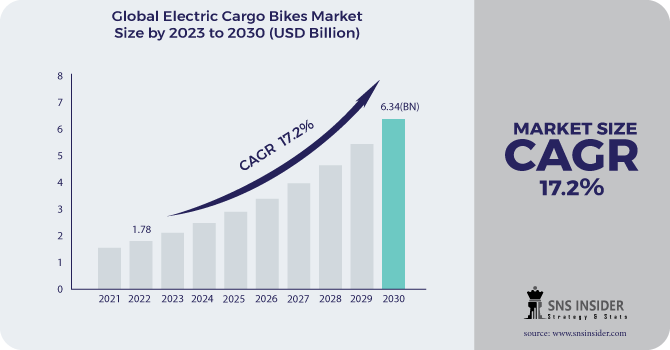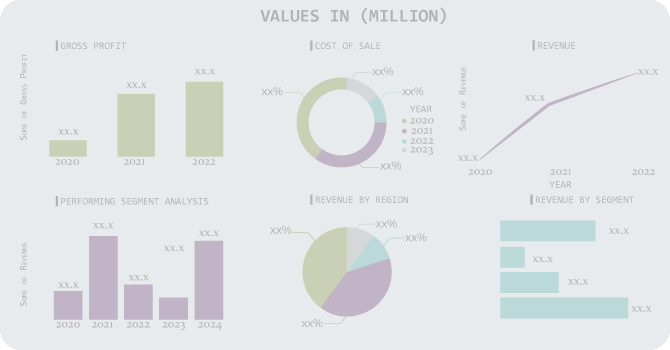Electric Cargo Bikes Market Report Scope & Overview
The Electric Cargo Bikes Market size was valued at USD 2.2 billion in 2023 and is expected to reach USD 5.14 billion by 2031 and grow at a CAGR of 11.2% over the forecast period 2024-2031.
Electric cargo bikes are revolutionizing transportation, enabling riders to carry heavy loads with ease due to electric motor assistance. This eco-friendly alternative to traditional vehicles is gaining traction due to several factors. The electric cargo bikes offer a cost-effective and sustainable mode of transportation. With rising concerns about environmental impact, electric bikes are a welcome change. Additionally, the rising e-commerce industry, particularly in developing economies, is driving demand for these efficient cargo carriers. The consumer preferences in developed nations are shifting from Internal combustion engine vehicles to electric cargo bikes, presenting exciting growth opportunities. Manufacturers are responding with increased investment in product development, focusing on high-performance, high-load capacity, and low-maintenance bikes. Technological advancements in the bicycle industry are another key driver of market growth. Thus, the growing demand for efficient and sustainable personal mobility solutions is fueling the electric cargo bike market.

Get More Information on Electric Cargo Bikes Market - Request Sample Report
MARKET DYNAMICS:
KEY DRIVERS:
-
Electric cargo bikes offer a sustainable and cost-effective alternative to car travel for both personal and commercial use.
Electric cargo bikes offering a compelling alternative to car travel for both individuals and businesses. Their electric motors provide a sustainable solution, eliminating tailpipe emissions and contributing to cleaner air. Thus, compared to cars, electric cargo bikes boast significant cost advantages. They require less maintenance, eliminate fuel expenses, and potentially avoid parking fees and congestion charges. This economic benefit makes them attractive for personal use, like grocery shopping or running errands. Businesses, particularly those focused on last-mile deliveries, can leverage electric cargo bikes for their efficiency and cost-effectiveness, making them a win-win for both the environment and the bottom line.
-
Manufacturers are investing heavily in developing high-performance, high-load capacity, and low-maintenance electric cargo bikes.
RESTRAINTS:
-
Lack of dedicated cycling infrastructure, like bike lanes and secure parking, can deter potential riders.
-
Higher upfront costs compared to traditional bicycles can be a barrier for some budget-conscious consumers.
The high upfront cost of electric cargo bikes can be a significant hurdle for some consumers as traditional bicycles offer a budget-friendly option for transportation. The price tag associated with these bikes reflects the investment in powerful electric motors, robust frames designed for heavy loads, and potentially additional features like weather protection or child seats. This can be a deciding factor for budget-conscious individuals who might be hesitant to make such a large initial investment, especially when compared to the lower cost of a traditional bike. This price barrier could potentially limit the market penetration of electric cargo bikes and hinder their widespread adoption as a mainstream transportation option.
OPPORTUNITIES:
-
Technological advancements in batteries offering greater range and shorter charging times can alleviate range anxiety and expand usability.
-
Growing awareness of the health benefits of cycling, coupled with the environmental advantages of electric cargo bikes, can attract a wider range of eco-conscious consumers.
CHALLENGES:
-
Higher upfront costs compared to traditional bikes can strain budget-conscious consumers.
-
Range anxiety, or the fear of running out of battery power with limited charging options, hinders long journeys.
IMPACT OF RUSSIA-UKRAINE WAR
The war in Russia-Ukraine has disrupted the electric cargo bike market and has exacerbated supply chain issues. Key raw materials like lithium, nickel, and aluminium, crucial for electric bike batteries and frames, are sourced from both Russia and Ukraine. The war has disrupted the flow of these materials, leading to price hikes of up to 70% for lithium and nickel. This translates to increased production costs for electric cargo bikes, potentially forcing manufacturers to raise their final selling prices. The surge in oil and gas prices has led to a rise in production costs for all manufactured goods, including electric cargo bikes. This further decreases the profit margins for manufacturers and could potentially decline consumer demand due to higher prices. The war has diverted resources away from research and development in the electric cargo bike industry. Governments in some countries are likely to prioritize defence spending over investments in green initiatives, potentially slowing down advancements in battery technology, motor efficiency, and overall cargo bike design.
IMPACT OF ECONOMIC SLOWDOWN
An economic slowdown can disrupt the electric cargo bike market in a few ways. Consumer spending tends to limit during recessions, and with a higher upfront cost compared to traditional bikes, electric cargo bikes might be seen as a non-essential purchase. Businesses, especially those in the early stages of adopting electric cargo bikes for deliveries, might re-evaluate their investments due to budget constraints. This could lead to a temporary decline in sales growth, potentially around 5-10% depending on the severity of the slowdown. The long-term impact might be less significant. Electric cargo bikes offer significant operational cost savings compared to cars and gas-powered delivery vehicles. As fuel prices typically rise during economic downturns, this could incentivize businesses to invest in electric cargo bikes for their long-term financial benefits.
KEY MARKET SEGMENTS:
By Product Type:
-
Two-wheeler
-
Three-wheeler
-
Four-wheeler
Two-wheeler is the dominating sub-segment in the Electric Cargo Bikes Market by product type holding around 70-80% of market share. Two-wheelers offer a greater balance between movability, affordability, and cargo capacity compared to three or four-wheelers. They are ideal for navigating city streets and personal use due to their smaller size and lower price point.
By Battery Type:
-
Lithium-ion
-
Lead-based
-
Nickel-based
Lithium-ion batteries is the dominating sub-segment in the Electric Cargo Bikes Market by battery type holding around 85-90% of market share. Lithium-ion batteries offer superior performance with higher energy density, lighter weight, and longer lifespans compared to lead-acid or nickel-based batteries. These advantages are crucial for electric cargo bikes to achieve extended range and efficient operation.
By End-Use:
-
Courier and Parcel Service Providers
-
Service Delivery
-
Personal Use
-
Waste Municipal Services
-
Large Retail Suppliers
-
Others
Courier and Parcel Service Providers is the dominating sub-segment in the Electric Cargo Bikes Market by end use. The rising popularity of e-commerce is driving demand for efficient and sustainable last-mile delivery solutions. Electric cargo bikes offer a cost-effective and eco-friendly alternative to traditional delivery vehicles, particularly in urban areas.
REGIONAL ANALYSES
The Asia-Pacific is the dominating region in the Electric Cargo Bike Market holding around 40-45% of market share. This region benefits from a well-developed cycling infrastructure and culture, making electric cargo bikes a seamless transition for personal and commercial use. The government support in the form of subsidies and incentives for electric vehicle adoption, including electric cargo bikes, further fuels market growth.
Europe is the second-highest region in this market. Dense urban environments with well-developed cycling infrastructure in many European cities make electric cargo bikes ideal for short trips and errands. Stricter emission regulations in some European countries are also pushing businesses and individuals towards cleaner transportation options, further propelling the market.
North America is experiencing the fastest growth rate, estimated at a CAGR of 18-22%. The manufacturers in this region are actively developing innovative and high-performance electric cargo bikes, making them even more attractive to consumers and contributing to the region's impressive growth trajectory.
REGIONAL COVERAGE:
North America
-
US
-
Canada
-
Mexico
Europe
-
Eastern Europe
-
Poland
-
Romania
-
Hungary
-
Turkey
-
Rest of Eastern Europe
-
-
Western Europe
-
Germany
-
France
-
UK
-
Italy
-
Spain
-
Netherlands
-
Switzerland
-
Austria
-
Rest of Western Europe
-
Asia Pacific
-
China
-
India
-
Japan
-
South Korea
-
Vietnam
-
Singapore
-
Australia
-
Rest of Asia Pacific
Middle East & Africa
-
Middle East
-
UAE
-
Egypt
-
Saudi Arabia
-
Qatar
-
Rest of Middle East
-
-
Africa
-
Nigeria
-
South Africa
-
Rest of Africa
-
Latin America
-
Brazil
-
Argentina
-
Colombia
-
Rest of Latin America
KEY PLAYERS:
Rad Power Bikes LLC (US), Yuba Electric Cargo Bikes (US), Jiangsu Xinri E-Vehicle Co., Ltd (China), Cero Electric Cargo Bikes (US), Urban Arrow, Douze Factory SAS(France), Xtracycle (US), Worksman Cycles (US), Riese & Müller GmbH (Germany) and Butchers & Bicycles (Denmark) are some of the affluent competitors with significant market share in the Electric Cargo Bikes Market.
Yuba Electric Cargo Bikes (US)-Company Financial Analysis

RECENT DEVELOPMENT
-
In March 2024: Rad Power Bikes has launched four new e-bike with its innovative Safe Shield Battery. This innovative battery boasts thermal resistance technology, raising the bar for safety and pushing the boundaries of e-bike design.
-
In July 2023: Xtracycle unveils a new off-road e-cargo bike for adventures. This powerhouse holds 3 passengers and boasts a long rear rack that doubles as a cargo platform or child carrier, making it perfect for families on the go.
-
In June 2023: Tern revamped their HSD compact cargo bike. This new version boasts increased strength, intelligence, and convenient features. It's a complete overhaul with the addition of Bosch's Smart System.
| Report Attributes | Details |
|---|---|
| Market Size in 2023 | US$ 2.2 Billion |
| Market Size by 2031 | US$ 5.14 Billion |
| CAGR | CAGR of 11.2% From 2024 to 2031 |
| Base Year | 2023 |
| Forecast Period | 2024-2031 |
| Historical Data | 2020-2022 |
| Report Scope & Coverage | Market Size, Segments Analysis, Competitive Landscape, Regional Analysis, DROC & SWOT Analysis, Forecast Outlook |
| Key Segments | • by Product Type (Two-wheeler, Three-wheeler, Four-wheeler) • by Battery Type (Lithium-ion, Lead-based, Nickel-based) • by End-use (Courier and Parcel Service Providers, Service Delivery, Personal Use, Waste Municipal Services, Large Retail Suppliers, Others) |
| Regional Analysis/Coverage | North America (US, Canada, Mexico), Europe (Eastern Europe [Poland, Romania, Hungary, Turkey, Rest of Eastern Europe] Western Europe] Germany, France, UK, Italy, Spain, Netherlands, Switzerland, Austria, Rest of Western Europe]), Asia Pacific (China, India, Japan, South Korea, Vietnam, Singapore, Australia, Rest of Asia Pacific), Middle East & Africa (Middle East [UAE, Egypt, Saudi Arabia, Qatar, Rest of Middle East], Africa [Nigeria, South Africa, Rest of Africa], Latin America (Brazil, Argentina, Colombia, Rest of Latin America) |
| Company Profiles | Rad Power Bikes LLC (US), Yuba Electric Cargo Bikes (US), Jiangsu Xinri E-Vehicle Co., Ltd (China), Cero Electric Cargo Bikes (US), Kocass Technology Co., Ltd. (China), Douze Factory SAS(France), Xtracycle (US), Worksman Cycles (US), Riese & Müller GmbH (Germany) and Butchers & Bicycles (Denmark) |
| Key Drivers | • Growth in demand for electric vehicles around the world is a result of technological improvements. • The need for electric cargo bikes may rise as a result of the growing popularity of electric automobiles. |
| RESTRAINTS | • Demand for electric cargo bikes is predicted to be deterred by their high price and battery size. • Cargo bikes have lower operating costs. |

